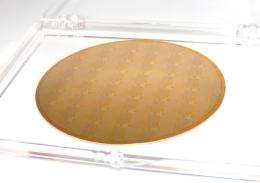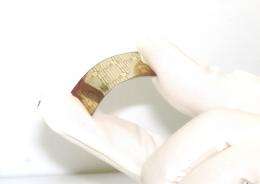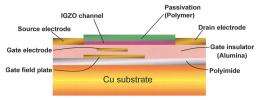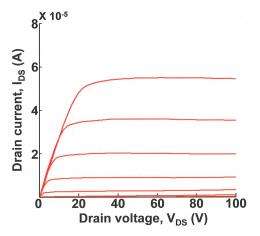Fujitsu develops technology to manufacture power-supply transistors on nearly any flat-surface material

Fujitsu Laboratories announced the development of a technology that enables the manufacture of power-supply transistors on nearly any flat surface, including glass, plastic, or copper. High breakdown-voltage was achieved by forming a high breakdown-voltage power-supply transistor on a target substance using zinc-oxide (ZnO) material and protecting the transistor's channel using a polymer layer. This new technology will enable power-supply circuits to be manufactured on a wide range of flat surfaces, with potential applications including sensors and piezoelectric devices.
Details of this technology were presented at the 2010 Materials Research Society Fall Meeting (2010 MRS Fall Meeting), being held in Boston from November 29 - December 3.

A major issue in reducing environmental footprints is reducing the power consumed by electrical power supplies in applications such as IT equipment, household appliances, and automobiles. At the same time, demand to lower the costs of general-purpose power-supply circuits has generated anticipation for the realization of low-cost power-supply transistors which feature high breakdown-voltages.
Zinc oxide is a wide band-gap semiconductor material that can be used as a power-supply transistor with low loss, and is a material that has potential for creating transistors on nearly any flat surface (Figure 1). Recently, there has been R&D underway for forming zinc oxide on glass substrates for transistors for liquid-crystal-display (LCD) televisions and monitors.
Fabricating ZnO as a power-supply transistor with high breakdown-voltage presents the challenge of lowering the density of the channel material - which is required for high breakdown-voltage - while suppressing the charge trap resident in the surface of the material, which can cause electrical-field concentration. These issues needed to be resolved in order to develop a technology that would allow for ZnO to be used as a high breakdown-voltage transistor in power supplies.
By employing indium-gallium-zinc-oxide (IGZO) as the material and protecting the transistor's channel with a polymer layer (Figure 2), Fujitsu Laboratories was able to produce a 100-V transistor for use in power supplies (Figure 3). In addition, because the high breakdown-voltage transistor can be manufactured directly on copper substrate which is used as a packaging material, heat dissipation is simplified and more easily achieved, and costs can be reduced.

The new technology can be applied to power circuits formed on any flat-surface material, and can be used for such applications as high-voltage sensors and piezoelectronic devices.

Fujitsu Laboratories will continue refine this new technology to make it suitable for power-supply transistors by further increasing the breakdown voltage and lowering the on-state resistance, and will strive toward incorporation of this technology in IT products around 2015.
Source: Fujitsu





















